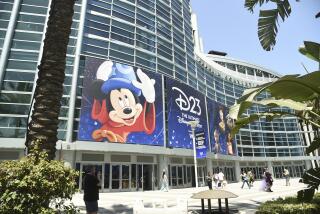Knott’s, Disney See Fewer Visitors : Amusement parks: Attendance is stable at other attractions in Southern California.
- Share via
Mickey Mouse and Snoopy were a little lonelier this year as attendance at Disneyland and Knott’s Berry Farm declined for the second consecutive year, Amusement Business magazine said.
But the number of visitors to three other Southern California amusement parks remained essentially the same, according to the magazine, which is considered authoritative in the industry. Sea World in San Diego had steady attendance figures in 1993, while Universal Studios Hollywood and Six Flags Magic Mountain in Valencia scored slight increases.
A spokesman for Knott’s, which features the Camp Snoopy attraction, said the magazine’s attendance estimate of 3.7 million for the Buena Park theme park is probably low. The final three months of this year “exceeded our plan,” spokesman Bob Ochsner said. The magazine estimated Knott’s 1992 attendance at 3.9 million.
Amusement Business estimated Disneyland attendance at 11.4 million, down 200,000 from 1992.
Disneyland officials would not comment on 1993 attendance, but Lindsay Schnebly, a spokesman for the Anaheim park, said Disneyland logged a strong year after adding the Mickey’s Toon Town and Aladdin’s Royal Caravan attractions. Industry estimates usually put the park’s annual attendance between 11 million and 13 million.
Despite the reduced figures, Disneyland held its place on the magazine’s list as the second-busiest amusement park in the nation. Knott’s, however, fell to ninth place, from seventh in 1992.
One reason for Knott’s drop is that the magazine counted Disney World in Florida as three separate attractions--the Magic Kingdom (ranked first in attendance), Epcot and Disney-MGM Studios--meaning it took up three of the top five spots this year.
The list became a “Top 50” this year instead of “Top 40” to avoid knocking some of the smaller parks off the bottom, said Tim O’Brien, an editor with the Nashville-based trade magazine.
Across the country, 1993 was a stronger year for amusement parks than was 1992, O’Brien said. But attendance figures--which are up only slightly nationwide--do not tell the whole story.
“They reflect popularity but not profitability,” O’Brien said. “They don’t tell how much people spend once they get in the park. From what I’m hearing, profitability is up tremendously,” as most of the nation has been in an economic recovery that has so far bypassed Southern California.
Many parks are charging slightly higher entry fees, O’Brien said, and better food has also boosted sales.
More to Read
Inside the business of entertainment
The Wide Shot brings you news, analysis and insights on everything from streaming wars to production — and what it all means for the future.
You may occasionally receive promotional content from the Los Angeles Times.










